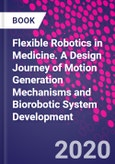Flexible Robotics in Medicine: A Design Journey of Motion Generation Mechanisms and Biorobotic System Development provides a resource of knowledge and successful prototypes regarding flexible robots in medicine. With specialists in the medical field increasingly utilizing robotics in medical procedures, it is vital to improve current knowledge regarding technologies available. This book covers the background, medical requirements, biomedical engineering principles, and new research on soft robots, including general flexible robotic systems, design specifications, design rationale, fabrication, verification experiments, actuators and sensors in flexible medical robotic systems.
Presenting several projects as examples, the authors also discuss the pipeline to develop a medical robotic system, including important milestones such as involved regulations, device classifications and medical standards.
Please Note: This is an On Demand product, delivery may take up to 11 working days after payment has been received.








